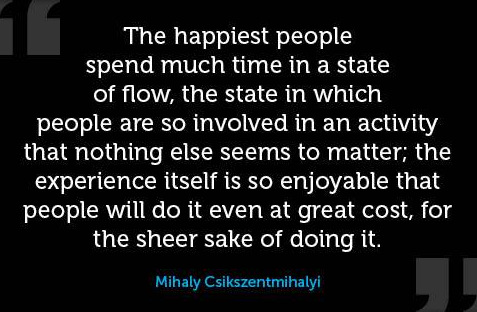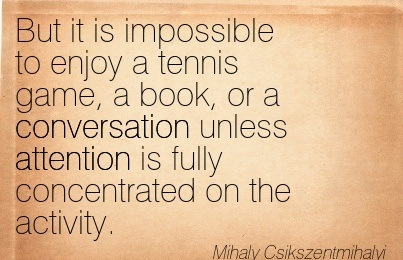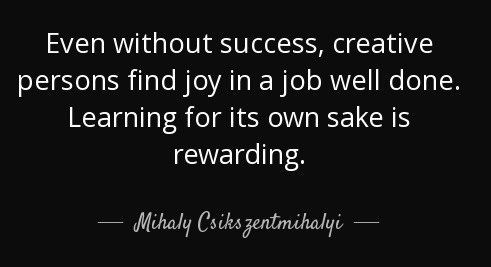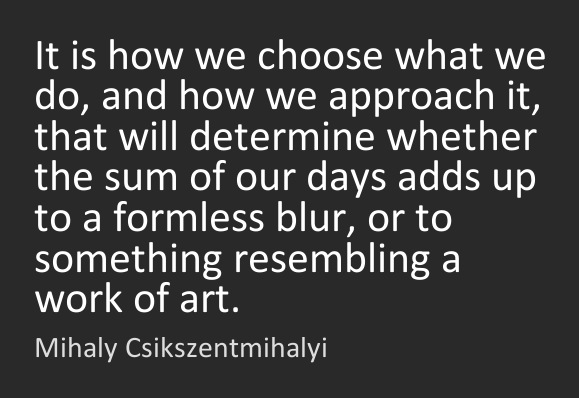 Every book on positive psychology these days contains a chapter on flow activities.
Every book on positive psychology these days contains a chapter on flow activities.
In the 1970s, a Hungarian psychologist named Mihaly Csikszentmihalyi started studying individuals who were routinely engaged in activities that absorbed them. Examples of such activities: dancing, outdoors activities, playing with a dog, painting, gardening and so on. Individuals pursued these activities for its own intrinsic value; they were not motivated by any external reward. They made effortless progress, they were fully focused, and they were not distracted by other thoughts. Csikszentmihalyi noted that individuals who routinely engaged in such activities (called 'flow activities') were happier in their overall lives and felt more satisfied.
Two excellent videos that explain the concept of flow:

A slide from a TED talk by Csikszentmihalyi.
- Activities with body movement: sports, athletics, dance, martial arts, outdoor activities like hiking & mountaineering.
- Artistic pursuits: music (composition, performance, hearing), arts and crafts.
- Home projects: gardening, home improvement activities, cooking, baking.
- Hobbies like writing, needlework, origami, pottery making.

Each color is clickable; takes you to Wikipedia article describing that emotion.
1) Concentration: The individual is completely absorbed in the activity. Nothing else seems to matter. The mind is not thinking about anything else. It is focused, concentrated. The individual doesn't pay attention to how much time has gone by. Time flies. Being 'in the groove' or 'in the zone' describe this state of mind.
2) Challenge vs Skill: Csikszentmihalyi emphasized that a balance must be struck between the skill level of the individual and the challenge presented by the task. If there is a mismatch between the two, some other state of mind occurs. See the image with 8 different states of mind. At one extreme is Apathy when both skill level and challenge are really low (watching television is an example activity that gets us into this state of mind). On the other extreme is Flow which requires a high skill level and a high degree of challenge.
3) Intrinsic Value: Csikszentmihalyi emphasized that individuals engaged in flow activities pursued their tasks because they saw intrinsic value in doing so, not because they were motivated by external rewards. Individuals with such traits are called autotelic. Csikszentmihalyi describes the autotelic personality as a trait possessed by individuals who can learn to enjoy situations that most other people would find miserable. Research has shown that aspects associated with the autotelic personality include curiosity, persistence, and humility.
The diagrams below shed further light on various combinations of skill and challenge.


Csikszentmihalyi's philosophy is brought out by his quotes listed below. As you browse through them, notice the similarity between Csikszentmihalyi's quotes and the following verse from Bhagavad Gita:
The meaning of this verse is:






Mihaly Csikszentmihalyi's original book on flow was published in 1990: Flow: The Psychology Optimal Experience (303 pages, 1990). Since then, Csikszentmihalyi has published several other books. His latest book is Running Flow (200 pages, 2017) by Mihaly Csikszentmihalyi, Philip Latter & Christine Weinkauff Duranso. A great review of the book is Dr. Mihaly Csikszentmihalyi Shares the Nine Components of RUNNING FLOW in New Book. This book review summarizes Csikszentmihalyi's key ideas nicely — worth reading.
I once read this article: Five States of Mind, maintained by Vedanta Society of Southern California. The article was originally published in 1980 in Prabuddha Bharata by Swami Bhajanananda, Assistant Secretary and Trustee of Ramakrishna Order.
The five states of mind are ksiptam (restless), mudham (dull), viksiptam (preoccupied), ekagram (concentrated) and niruddham (closed). Which of these states of mind results from flow activities? Let us first browse through an excerpt from the article that defines these 5 states of mind:
I believe that flow activities described by Mihaly Csikszentmihalyi take us into the 'viksiptam' state of mind. This is the state of mind in which doctors, engineers, dancers and artists find themselves. In these activities, the mind is limited to a small number of thoughts, all related to the task at hand. However, there is another state of mind called 'ekagram' (known as 'ekaggata' in Pali) which is aquired through meditative practices. I encourage my friends who are software engineers or research scientists to pick up meditation to experience this state of mind. As the excerpt above indicates, meditation is easier for those whose predominant state of mind is 'viksiptam', as compared to those who are predominantly in 'ksiptam' (restless) or 'mudham' (dull).
To learn meditation, I attended the 10-Day Vipassana Silent Retreats in which we are taught breath meditation and insight meditation.
I'm not able to grasp the fifth state of mind called 'niruddham' from is textual description. This state of mind is probably obtained when we have gotten rid of all sankharas and no new response patterns are developed in our mind, leaving us equanimous at all times.
How may we experience the mental state called 'ekagram' which was explained in the article by Swami Bhajanananda (see the previous section)? There are many contemporary techniques. Some of the ancient techniques are believed to have been lost because we no longer have teachers who understand nuances of those techniques.
Let us study what Ramana Maharshi (1879 - 1950) says. Let's browse through Question 12 in Who Am I? by Ramana Maharshi. The question is:
Are there no other means for making the mind quiescent?
The answer is in three paragraphs. The second paragraph is:
Like the practice of breath-control. meditation on the forms of God, repetition of mantras, restriction on food, etc., are but aids for rendering the mind quiescent.
and the first line of the third paragraph is:
Through meditation on the forms of God and through repetition of mantras, the mind becomes one-pointed.
The word one-pointed means 'ekagram'; see Wikipedia article for Ekaggata. In the answer to Q12, Ramana Maharshi does not mention that you can taste 'ekaggata' (experience this state of mind at least temporarily) via music or work or service — all of these are awesome activities and should actually be pursued by us. But for experiencing 'ekaggata', Ramana Maharshi lists meditation techniques (and breath control techniques like Pranayama) as tools to quiesce the mind (at least temporarily). And throughout the article, he insists that 'self inquiry' is the key for permanently experiencing a quiescent mind. But 'self inquiry' becomes easier if we can experience 'ekaggata' / 'ekagram' / 'one-pointedness' first.
Individuals who engage in flow activities feel joyful and content. Csikszentmihalyi emphasizes that there should be a good match between the skills required and the challenge associated with the activity being done. However, is it important for the activity to be challenging for us to feel joyful and content? Is it possible to feel this way even when the activity is mundane? In fact, is it possible to be joyful and content at all times in a day, no matter what activity we're engaged in? Yes! Mindfulness practices make that happen.
A great book on mindfulness is The Miracle of Mindfulness (140 pages, 1999) by Thich Nhat Hanh, a famous Vietnamese Buddhist monk. In 1967, Martin Luther King nominated him for the Nobel Prize. The Miracle of Mindfulness is a short, high quality book that explains how to incorporate meditation into our daily lives. The beauty of the book lies in its depth of ideas presented in simple language. For me, this book special is just reading the first few chapters of this book makes me feel calmer.
Practical Insight Meditation (16 pages, 1944) by Mahasi Sayadaw would be a good booklet to complement Thich Nhat Hanh's book. Mahasi Sayadaw's booklet also has precise instructions on how to practice mindfulness in our day to day lives.
Instead of reading books, it is best to learn mindfulness techniques from authentic teachers. One such place is the 10-day silent retreats which I found super awesome!
► Next article in this section?
► Explore another section?

